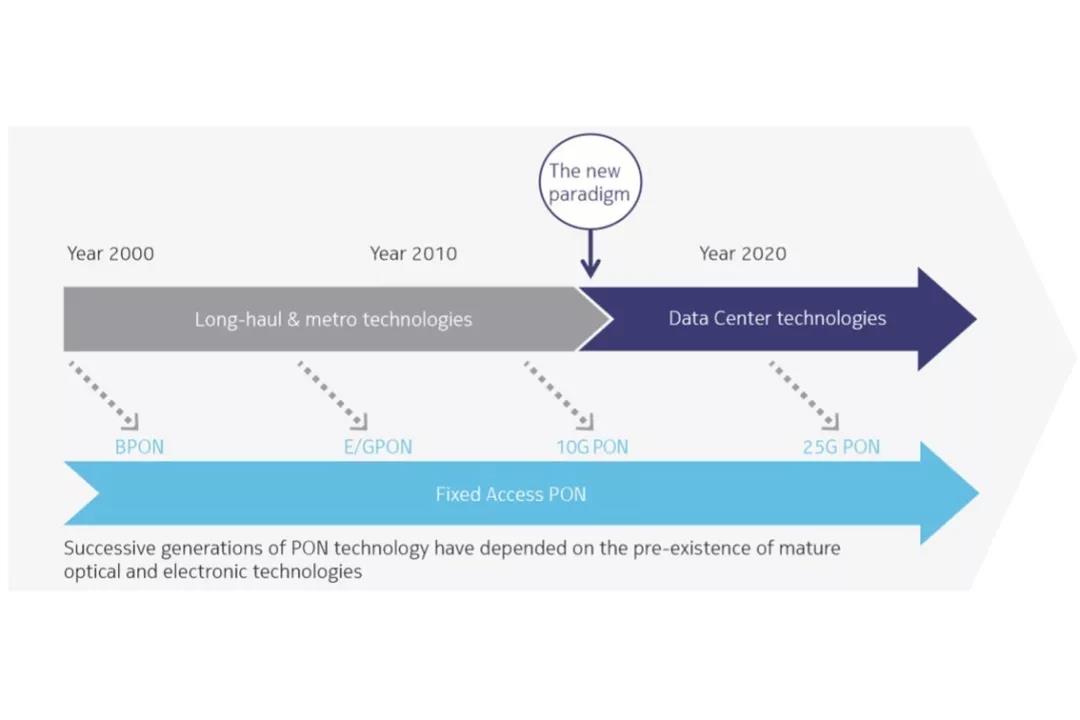PON technology has always had the ability to reinvent itself and adapt to new market demands. From record speed to dual rate bit rate and multiple lambdas, PON has always been a “hero” of broadband, which enables the widespread adoption and operation of new services. The promotion of business is possible.
As the 5G network begins to build, the PON story is also opening a new page.This time, next-generation PON technology is adopting a new paradigm to achieve higher capacity more efficiently.The 25G PON will leverage the data center ecosystem, rather than the transmission system used in the history of PON technology, which represents the next phase of fiber evolution, a new dimension in the PON story.
Cost effectiveness is the key
There are two requirements for access technology success: cost-effectiveness and market demand. In the large-scale access network deployment, the former is the key. Leveraging proven ecosystems and high-capacity optical technologies can help achieve cost-effectiveness while further improving cost-effectiveness based on research and innovation.
Thus, the commercial success of 25G PON will depend on its ability to provide 2.5 times more bandwidth than 10G PON at a lower cost. Fortunately, 25G PON has the most cost-effective way to go beyond 10G PON because it will leverage the high-capacity 25G optical technology used to interconnect data centers.
As data center deployments increase, the number of 25G optics will increase and the cost of the device will decrease. Of course, it is not possible to directly plug these data center components into optical line termination (OLT) and optical network unit (ONU) transceivers, which will require new wavelengths, higher transmit power of the transmitter, and higher sensitivity of the receiver.
However, this is no different from previous generation PONs using components from long-haul and metro transceivers. In addition, 25G is a simple TDM technology that does not require expensive tunable lasers.
Clear application scenario
Regarding market demand, the second factor required for 25G PON success is to ensure that 25G has clear use cases, including residential, commercial, and so on. The residential market can provide the opportunity to aggregate Gigabit services on high-density PONs; in the commercial sector, 25G will provide 10G or higher services to expand services to businesses.
In addition, with the 5G era, long-distance transmission requires 25G. Although XGS-PON or 10G PTP can effectively solve the mid-range and backhaul problems, due to the increase of RF bandwidth and MIMO antenna layer, 25G PON is needed in the case of high density and high single cell throughput. At the same time, 25G PON is compliant with mobile network evolution because the 25G physical interface will be used for both centralized and distributed units.
Other sounds
As usual, the industry is studying various options for PON evolution. For example, 50G PON has been proposed, but it poses a premature ecosystem challenge that will not improve until 2025, and there is currently no visibility into the 50G business scenario.
Figure: Several generations of PON technology rely on proven optical and electronic technologies
Another solution considered is to perform 2x10G bonding on two non-tunable wavelengths. The solution uses a GPON wavelength and an XGS wavelength. Unfortunately, this approach brings higher costs (twice the 10G optics), increased complexity, and lack of the ability to coexist with current GPON deployments, so there is no market appeal.
A similar problem can occur with the 2xTWDM tunable wavelength bonding method. TWDM is already very expensive, requiring two lasers to connect wavelengths in an ONU, which makes the cost of large-scale deployment even higher.
25G PON is the most efficient way to evolve a fiber-optic network to the next generation, a simple technique that uses a single wavelength and does not require a tuned laser.
It coexists with GPON and XGS-PON and offers higher 25Gb/s downstream rates and 25Gb/s or 10Gb/s upstream rates. It is also based on proven optical technology and an evolving ecosystem that enables this technology to be brought to market faster. It can meet higher density residential, commercial and other needs in the short term, while coping with the competitive threat of 25G EPON and cable operators.






